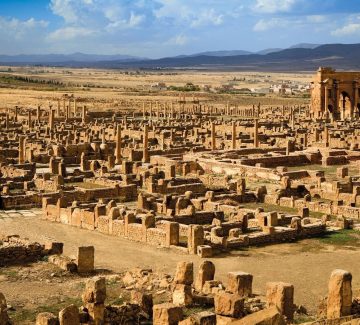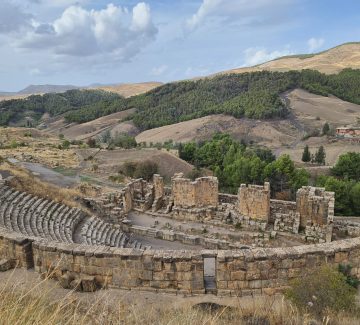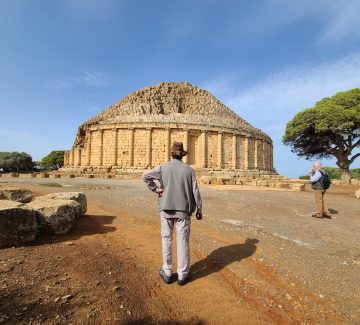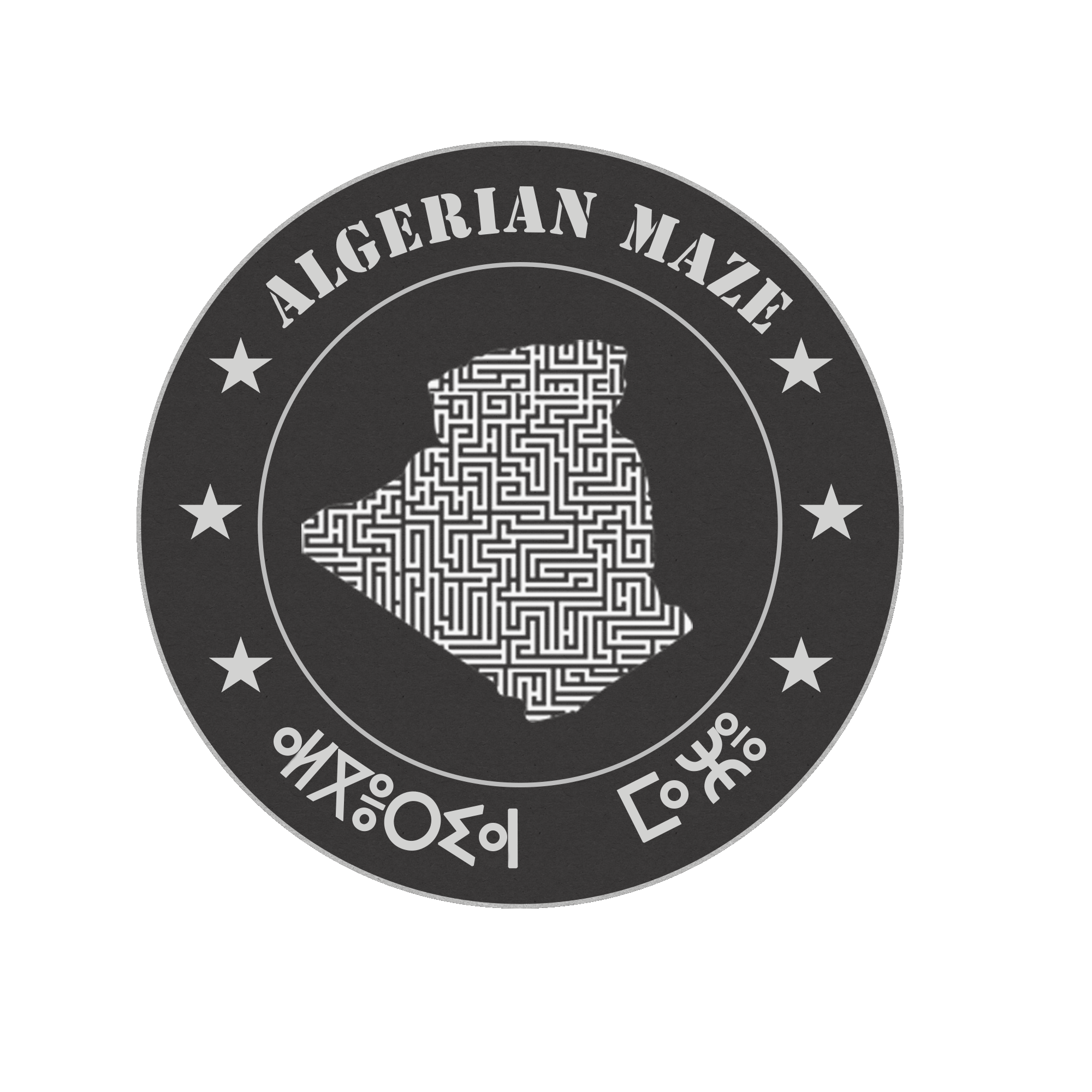THE ROMANALGERIA
the Roman wanted to leave their marks in each inch they land on it, in Algeria many cities witness their presence and the ruins that left tell stories and show mysterious facts of the life during that period.
PHOTOS AND VIDEOS
BEST PLACES TO TAKE UNIQUE PICTURES
UNESCO SITES
MORE THEN THREE UNESCO SITES
LUCKY TRAVELLER
ONE OF THE FIRST WHO VISIT THIS SITES BECAUSE ALGERIA IS UNKNOWN DESTINATION
ROMAN ALGERIA TRIP
FROM 800€
Accommodations Described in Tour Plan
Acommodation Options :3,4,5 stars
INCLUDED
- Airport Pick-up & Drop-off
- Breakfasts
- Domestic Flights
- Driver & Private Transportation
- English-Speaking Guide/Manager
- Entrance Fees to Sites
- Letter of Invitation for Visa Application
- Security Escort Where Needed (determined by Tour Manager)
- Water in Vehicle
NOT INCLUDED
- Alcahol drinks
- Gratuities
- International Flights
- Personal Spending Money
- Travel Insurance
PROGRAM OF THE TOUR

NOTES
- This trip it is all inclusive
- not for participants with heart problems
- physical ability level for this trip at least 6/10
- Not accesible to wheelchaire in some sites
- this trip need to be booked at least 10days before .
- this program can be adjusted to your need incase there is special situation .
- This program is prepared with 4 stars hotel ,but if you wish better then it can be arranged.
- Airport reception transfer to your hotel.
- welcome diner in traditional restaurant.
- breasfast at your hotel , meet the guide in the reception area.
- visit Cherchel the Capital of Moritanian Cesarians.
- visit Tipaza
- Have lunch in sea food restaurant .
- go back to Algiers and spent the night in the hotel .
- Breakfast at the hotel
- Djemila site
- Lunch
- Museum
- Take the road to Constantine
- Diner, check in the hotel
- Breakfast at the hotel
- take the road to Tiddis site
- go back to the centre of the city
- after lunch we visit the city of constantine
- diner and night at the hotel
- Breakfast at the hotel
- Visite Timgad
- Lunch
- check in the hotel of Batna city
- Dinner
- Breakfast at the hotel
- Visite Guelma
- Lunch
- take the road to Annaba city
- night in hotel
- dinner
- breakfast
- visite ANNABA
- Take the plane to Algiers
- night and diner in Algiers
- Breakfast and checkout in the hotel
- transfer to the aiport
ONE DAY TRIP TO A ROMAN SITE
we can offer a day trip to any of the mentionned roman sites in the perevious program

TIMGAD
Timgad, located to the north of the massif of the Aurès in a mountainous site of great beauty, 480 km south-east of Algiers and 110 km to the south of Constantine, is a consummate example of a Roman military colony created ex nihilo. The Colonia Marciana Traiana Thamugadi was founded in 100 A.D. by Trajan, probably as an encampment for the 3rd Augustan Legion which, thereafter, was quartered at Lambaesis. Its plan, laid out with great precision, illustrates Roman urban planning at its height. By the middle of the 2nd century, the rapid growth of the city had ruptured the narrow confines of its original foundation. Timgad spread beyond the perimeters of its ramparts and several major public buildings are built in the new quarters: Capitolium, temples, markets and baths. Most of these buildings date from the Severan period when the city enjoyed its Golden Age, also attested by immense private residences.

DJEMILA
The site of Djémila is located 50 km north-east of the town of Sétif. Known under its antique name Cuicul, Djémila is an establishment of an ancient Roman colony founded during the reign of Nerva (96 – 98 A.D.). The Roman town occupied a singular defensive position. Cuicul is one of the flowers of Roman architecture in North Africa. Remarkably adapted to the constraints of the mountainous site, on a rocky spur which spreads at an altitude of 900 m, between the wadi Guergour and the wadi Betame, two mountain torrents, the town has its own Senate and Forum. Around the beginning of the 3rd century, it expanded beyond its ramparts with the creation of the Septimius Severus Temple, the Arch of Caracalla, the market and the civil basilica. The site has also been marked by Christianity in the form of several cult buildings: a cathedral, a church and its baptistry are considered among the biggest of the Paleochristian period. The site of Djémila comprises an impressive collection of mosaic pavings, illustrating mythological tales and scenes of daily life.

TIPAZA
Tipasa, which offers a harbour and sheltered beaches, was settled by Phoenician sailors seeking anchorage as they traveled along North African coastal routes. The earliest traces of the Phoenician presence at Tipasa are tombs, the oldest of which date to the 6th century BCE. Artifacts found at those sites provide evidence of trade with Italy, Greece, and the Iberian Peninsula during the Phoenician period.
By the 1st century BCE, Mauretania, the North African region in which Tipasa was located, had come under indirect Roman rule. The Roman emperor Claudius granted Tipasa Latin rights (partial citizenship) when he annexed Mauretania in 43 CE. Tipasa became a colony (with full Roman citizenship) sometime within the following 150 years. Under Roman rule the city acquired greater commercial and military importance because of its harbour and its central position on the system of Roman coastal roads in North Africa. A wall of approximately 7,500 feet (2,300 metres) was built around the city for defense against nomadic tribes, and Roman public buildings and districts of houses were constructed within the enclosure.

TIDDIS
Hovering on a barren mountain slope, some 30km from Constantine, the ruined Roman town of Tiddis is perhaps the most impressively situated of all Algeria’s Roman sites. However, the ruins themselves are fairly weather beaten and cannot compare with some of the more famous Roman cities around these parts.
There’s been a settlement on this site at least since the Neolithic Berbers, but it was the Romans who developed Castellum Tidditanorum, which, as its name suggests, was a castellum or fortress, one of a series of fortified villages that surrounded the larger settlement at Constantine (then Cirta) and protected its territory.
The Romans arrived during the age of Augustus, but built much of what can now be seen in the 3rd century AD, adapting their fundamental rule of town planning – two straight central streets that cross at the heart of the community – to the curves of the site. Tiddis had no water sources, so one of the most interesting features of the houses here are the channels and cisterns. They were designed to preserve the rains that fell, on which the community depended during the long, hot summers.
